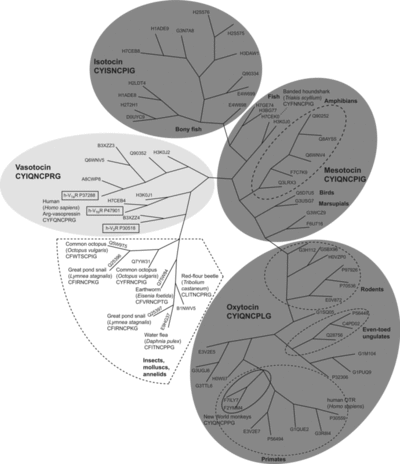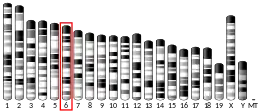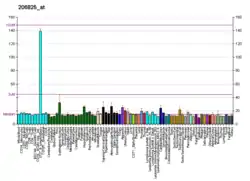Oxytocin receptor
The oxytocin receptor, also known as OXTR, is a protein which functions as receptor for the hormone and neurotransmitter oxytocin.[4][5] In humans, the oxytocin receptor is encoded by the OXTR gene[6][7] which has been localized to human chromosome 3p25.[8]
Function and location
The OXTR protein belongs to the G-protein coupled receptor family, specifically Gq,[4] and acts as a receptor for oxytocin. Its activity is mediated by G proteins that activate several different second messenger systems.[10][11]
Oxytocin receptors are expressed by the myoepithelial cells of the mammary gland, and in both the myometrium and endometrium of the uterus at the end of pregnancy. The oxytocin-oxytocin receptor system plays an important role as an inducer of uterine contractions during parturition and of milk ejection.
Oxytocin receptors are also present in the central nervous system. These receptors modulate a variety of behaviors, including stress and anxiety, social memory and recognition, sexual and aggressive behaviors, bonding (affiliation) and maternal behavior.[12][13][14] (See the oxytocin article for more details.)
In some mammals, oxytocin receptors are also found in the kidney and heart.
Mesolimbic dopamine pathways
The oxytocinergic circuit projecting from the paraventricular hypothalamic nucleus (PVN) innervates the ventral tegmental area (VTA) dopaminergic neurons that project to the nucleus accumbens, i.e., the mesolimbic pathway.[15] Activation of the PVN→VTA projection by oxytocin affects sexual, social, and addictive behavior via this link to the mesolimbic pathway;[15] specifically, oxytocin exerts a prosexual and prosocial effect in this region.[15]
Polymorphism
The receptors for oxytocin (OXTR) have genetic differences with varied effects on individual behavior. The polymorphism (rs53576) occurs on the third intron of OXTR in three types: GG, AG, AA. The GG allele is connected with oxytocin levels in people . A-allele carrier individuals are associated with more sensitivity to stress, fewer social skills, and more mental health issues than the GG-carriers.[16]
In a study looking at empathy and stress, individuals with the allele GG scored higher than A-carrier individuals in a "Reading the Mind in the Eyes" test. GG carriers, with their naturally higher levels of oxytocin , were better able to distinguish between emotions. A-allele carriers responded with more stress to stressful situations than GG-allele carriers.[17] A-allele carriers had lower scores on psychological resources, like optimism, mastery, and self-esteem, than GG individuals when measured with factor analysis for depressive symptomology and psychological resources, along with the Beck Depression Inventory. A-allele carriers had higher depressive symptomology and lower psychological resources than GG individuals.[16] A-allele individuals scored lower in human sociality than GG people on a Tridimensional Personality Questionnaire. AA individuals had the lowest amygdala activation while processing emotionally salient information and those with GG had the highest activity when tested using BOLD during an fMRI.[18]
A study looking at facial recognition in British and Finnish families with a single high-functioning autistic child found that a single change in the DNA had a major impact on face memory,[19] with AA individuals having impaired SD scores.[20]
The frequency of the A allele varies among ethnic groups, being significantly more common among East Asians than Europeans.[21]
Ligands
Several selective ligands for the oxytocin receptor have recently been developed, but close similarity between the oxytocin and related vasopressin receptors make it difficult to achieve high selectivity with peptide derivatives.[22][23] However the search for a druggable, non-peptide template has led to several potent, highly selective, orally bioavailable oxytocin antagonists.[24]
Agonists
- Peptide
- Non-peptide
- TC OT 39 – non-selective over vasopressin receptors
- WAY-267,464 – anxiolytic in mice; possibly non-selective over vasopressin receptors[23][25][26]
Antagonists
- Peptide
- Non-peptide
References
- GRCm38: Ensembl release 89: ENSMUSG00000049112 - Ensembl, May 2017
- "Human PubMed Reference:". National Center for Biotechnology Information, U.S. National Library of Medicine.
- "Mouse PubMed Reference:". National Center for Biotechnology Information, U.S. National Library of Medicine.
- Gimpl G, Fahrenholz F (April 2001). "The oxytocin receptor system: structure, function, and regulation". Physiological Reviews. 81 (2): 629–83. doi:10.1152/physrev.2001.81.2.629. PMID 11274341. S2CID 13265083.
- Zingg HH, Laporte SA (July 2003). "The oxytocin receptor". Trends in Endocrinology and Metabolism. 14 (5): 222–7. doi:10.1016/S1043-2760(03)00080-8. PMID 12826328. S2CID 21540056.
- EntrezGene 5021
- Kimura T, Tanizawa O, Mori K, Brownstein MJ, Okayama H (April 1992). "Structure and expression of a human oxytocin receptor". Nature. 356 (6369): 526–9. Bibcode:1992Natur.356..526K. doi:10.1038/356526a0. PMID 1313946. S2CID 4273722.
- Simmons CF, Clancy TE, Quan R, Knoll JH (April 1995). "The oxytocin receptor gene (OXTR) localizes to human chromosome 3p25 by fluorescence in situ hybridization and PCR analysis of somatic cell hybrids". Genomics. 26 (3): 623–5. doi:10.1016/0888-7543(95)80188-R. PMID 7607693.
- Koehbach J, Stockner T, Bergmayr C, Muttenthaler M, Gruber CW (February 2013). "Insights into the molecular evolution of oxytocin receptor ligand binding". Biochemical Society Transactions. 41 (1): 197–204. doi:10.1042/BST20120256. PMC 3634130. PMID 23356283.
- Devost D, Wrzal P, Zingg HH (2008). "Oxytocin receptor signalling". Advances in Vasopressin and Oxytocin — from Genes to Behaviour to Disease. Progress in Brain Research. 170. pp. 167–76. doi:10.1016/S0079-6123(08)00415-9. ISBN 978-0-444-53201-5. PMID 18655881.
- Gimpl G, Reitz J, Brauer S, Trossen C (2008). "Oxytocin receptors: ligand binding, signalling and cholesterol dependence". Advances in Vasopressin and Oxytocin — from Genes to Behaviour to Disease. Progress in Brain Research. 170. pp. 193–204. doi:10.1016/S0079-6123(08)00417-2. ISBN 978-0-444-53201-5. PMID 18655883.
- Caldwell HK, Young WS (2006). "Oxytocin and Vasopressin: Genetics and Behavioral Implications". In Lajtha A, Ramon L (eds.). Handbook of Neurochemistry and Molecular Neurobiology (3rd ed.). Berlin: Springer. pp. 573–607. ISBN 978-0-387-30348-2.
- Kiss A, Mikkelsen JD (September 2005). "Oxytocin--anatomy and functional assignments: a minireview" (PDF). Endocrine Regulations. 39 (3): 97–105. PMID 16468232.
- Veenema AH, Neumann ID (2008). "Central vasopressin and oxytocin release: regulation of complex social behaviours". Advances in Vasopressin and Oxytocin — from Genes to Behaviour to Disease. Progress in Brain Research. 170. pp. 261–76. doi:10.1016/S0079-6123(08)00422-6. ISBN 978-0-444-53201-5. PMID 18655888.
- McGregor IS, Callaghan PD, Hunt GE (May 2008). "From ultrasocial to antisocial: a role for oxytocin in the acute reinforcing effects and long-term adverse consequences of drug use?". British Journal of Pharmacology. 154 (2): 358–68. doi:10.1038/bjp.2008.132. PMC 2442436. PMID 18475254.
Recent studies also highlight remarkable anxiolytic and prosocial effects of intranasally administered OT in humans, including increased ‘trust’, decreased amygdala activation towards fear-inducing stimuli, improved recognition of social cues and increased gaze directed towards the eye regions of others (Kirsch et al., 2005; Kosfeld et al., 2005; Domes et al., 2006; Guastella et al., 2008).
- Saphire-Bernstein S, Way BM, Kim HS, Sherman DK, Taylor SE (September 2011). "Oxytocin receptor gene (OXTR) is related to psychological resources". Proceedings of the National Academy of Sciences of the United States of America. 108 (37): 15118–22. Bibcode:2011PNAS..10815118S. doi:10.1073/pnas.1113137108. PMC 3174632. PMID 21896752.
- Rodrigues SM, Saslow LR, Garcia N, John OP, Keltner D (December 2009). "Oxytocin receptor genetic variation relates to empathy and stress reactivity in humans". Proceedings of the National Academy of Sciences of the United States of America. 106 (50): 21437–41. Bibcode:2009PNAS..10621437R. doi:10.1073/pnas.0909579106. PMC 2795557. PMID 19934046.
- Tost H, Kolachana B, Hakimi S, Lemaitre H, Verchinski BA, Mattay VS, Weinberger DR, Meyer-Lindenberg A (August 2010). "A common allele in the oxytocin receptor gene (OXTR) impacts prosocial temperament and human hypothalamic-limbic structure and function". Proceedings of the National Academy of Sciences of the United States of America. 107 (31): 13936–41. Bibcode:2010PNAS..10713936T. doi:10.1073/pnas.1003296107. PMC 2922278. PMID 20647384.
- "Gene That Influences the Ability to Remember Faces Identified". Science Daily. 23 December 2013.
- Skuse; et al. (19 December 2013). "Common polymorphism in the oxytocin receptor gene (OXTR) is associated with human social recognition skills". Proceedings of the National Academy of Sciences. 111 (5): 1987–1992. doi:10.1073/pnas.1302985111. PMC 3918840. PMID 24367110.
- Sasaki JY, Kim HS, Xu J (July 2011). "Religion and Well-being: The Moderating Role of Culture and the Oxytocin Receptor (OXTR) Gene" (PDF). Journal of Cross-Cultural Psychology. 42 (8): 1394–1405. doi:10.1177/0022022111412526. S2CID 145567198.
- Chini B, Manning M (August 2007). "Agonist selectivity in the oxytocin/vasopressin receptor family: new insights and challenges". Biochemical Society Transactions. 35 (Pt 4): 737–41. doi:10.1042/BST0350737. PMID 17635137.
- Manning M, Stoev S, Chini B, Durroux T, Mouillac B, Guillon G (2008). "Peptide and non-peptide agonists and antagonists for the vasopressin and oxytocin V1a, V1b, V2 and OT receptors: Research tools and potential therapeutic agents☆". Peptide and non-peptide agonists and antagonists for the vasopressin and oxytocin V1a, V1b, V2 and OT receptors: research tools and potential therapeutic agents. Progress in Brain Research. 170. pp. 473–512. doi:10.1016/S0079-6123(08)00437-8. ISBN 978-0-444-53201-5. PMID 18655903.
- Borthwick AD (September 2010). "Oral oxytocin antagonists". Journal of Medicinal Chemistry. 53 (18): 6525–38. doi:10.1021/jm901812z. PMID 20550119.
- Rahman Z, Resnick L, Rosenzweig-Lipson SJ, Ring RH,"Methods of treatment using oxytocin receptor agonists", US patent application 2007/0117794, published 2007-05-24 , assigned to Wyeth Corp
- Ring RH, Schechter LE, Leonard SK, Dwyer JM, Platt BJ, Graf R, Grauer S, Pulicicchio C, Resnick L, Rahman Z, Sukoff Rizzo SJ, Luo B, Beyer CE, Logue SF, Marquis KL, Hughes ZA, Rosenzweig-Lipson S (January 2010). "Receptor and behavioral pharmacology of WAY-267464, a non-peptide oxytocin receptor agonist". Neuropharmacology. 58 (1): 69–77. doi:10.1016/j.neuropharm.2009.07.016. PMID 19615387. S2CID 8592340.
- Borthwick AD, Liddle J (January 2013). "Retosiban and Epelsiban: Potent and Selective Orally available Oxytocin Antagonists". In Domling A (ed.). Methods and Principles in Medicinal Chemistry: Protein-Protein Interactions in Drug Discovery. Weinheim: Wiley-VCH. pp. 225–256. doi:10.1002/9783527648207.ch10. ISBN 978-3-527-33107-9.
- Williams PD, Anderson PS, Ball RG, Bock MG, Carroll L, Chiu SH, Clineschmidt BV, Culberson JC, Erb JM, Evans BE (March 1994). "1-((7,7-Dimethyl-2(S)-(2(S)-amino-4-(methylsulfonyl)butyramido)bicyclo [2.2.1]-heptan-1(S)-yl)methyl)sulfonyl)-4-(2-methylphenyl)piperaz ine (L-368,899): an orally bioavailable, non-peptide oxytocin antagonist with potential utility for managing preterm labor". Journal of Medicinal Chemistry. 37 (5): 565–71. doi:10.1021/jm00031a004. PMID 8126695.
- Boccia ML, Goursaud AP, Bachevalier J, Anderson KD, Pedersen CA (September 2007). "Peripherally administered non-peptide oxytocin antagonist, L368,899, accumulates in limbic brain areas: a new pharmacological tool for the study of social motivation in non-human primates". Hormones and Behavior. 52 (3): 344–51. doi:10.1016/j.yhbeh.2007.05.009. PMC 2712625. PMID 17583705.
- Williams PD, Clineschmidt BV, Erb JM, Freidinger RM, Guidotti MT, Lis EV, Pawluczyk JM, Pettibone DJ, Reiss DR, Veber DF (November 1995). "1-(1-[4-[(N-acetyl-4-piperidinyl)oxy]-2-methoxybenzoyl]piperidin-4- yl)-4H-3,1-benzoxazin-2(1H)-one (L-371,257): a new, orally bioavailable, non-peptide oxytocin antagonist". Journal of Medicinal Chemistry. 38 (23): 4634–6. doi:10.1021/jm00023a002. PMID 7473590.
- Wyatt PG, Allen MJ, Chilcott J, Foster A, Livermore DG, Mordaunt JE, Scicinski J, Woollard PM (May 2002). "Identification of potent and selective oxytocin antagonists. Part 1: indole and benzofuran derivatives". Bioorganic & Medicinal Chemistry Letters. 12 (10): 1399–404. doi:10.1016/S0960-894X(02)00159-2. PMID 11992786.
- Ring RH, Malberg JE, Potestio L, Ping J, Boikess S, Luo B, Schechter LE, Rizzo S, Rahman Z, Rosenzweig-Lipson S (April 2006). "Anxiolytic-like activity of oxytocin in male mice: behavioral and autonomic evidence, therapeutic implications". Psychopharmacology. 185 (2): 218–25. doi:10.1007/s00213-005-0293-z. PMID 16418825. S2CID 13647805.
External links
| Wikimedia Commons has media related to Oxytocin receptors. |
- Oxytocin+receptor at the US National Library of Medicine Medical Subject Headings (MeSH)
- "Symbol Report: OXTR". HUGO Gene Nomenclature Committee.
- "Vasopressin and Oxytocin Receptors: OT". IUPHAR Database of Receptors and Ion Channels. International Union of Basic and Clinical Pharmacology.
This article incorporates text from the United States National Library of Medicine, which is in the public domain.



